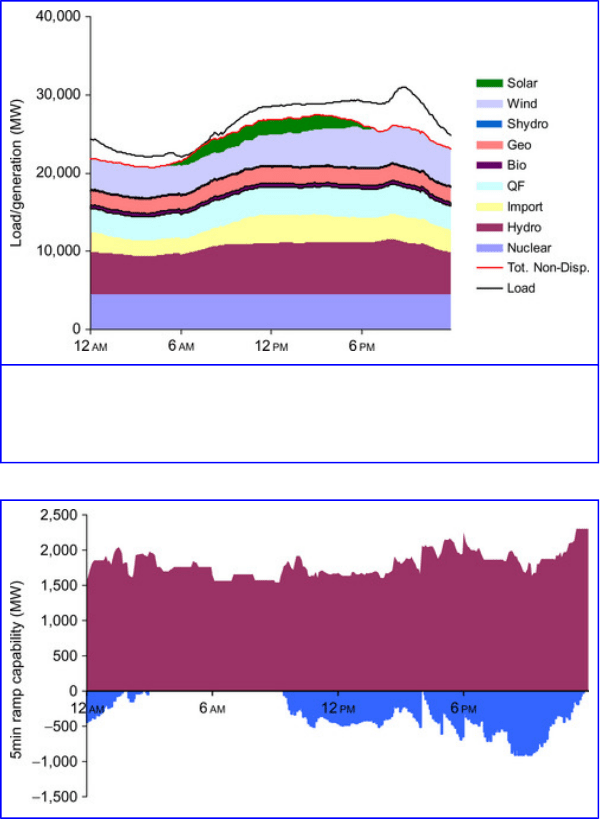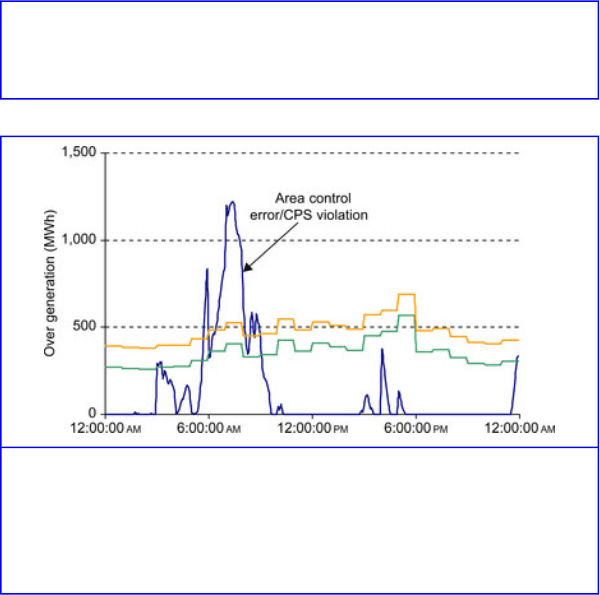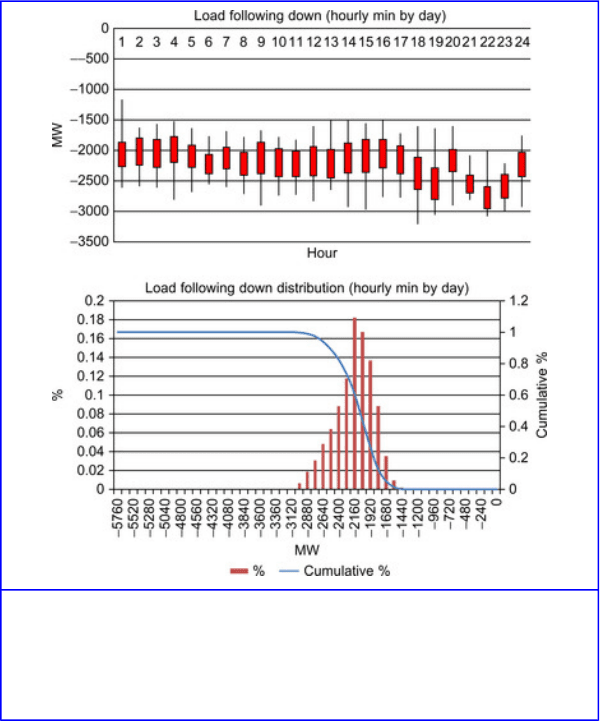Sioshansi F.P. Smart Grid: Integrating Renewable, Distributed & Efficient Energy
Подождите немного. Документ загружается.

process known as “once-through cooling,” which takes water
in for cooling purposes and then returns it to the environment.
Concern about the environmental damage from this process
has led the State Water Resources Control Board to determine
that all such power plants must either retire or repower over
the next decade; yet many of these resources provide much of
the inertia and dispatchable capacity the system relies on for
real-time balancing.
The uncertainty about the future availability of existing
conventional resources is further complicated by the changing
economics of conventional resources. As larger amounts of
the state's energy is provided by renewable resources,
conventional dispatchable generation will likely see their spot
market energy revenues decrease while they experience
greater numbers of startups and shutdowns, increased
ramping, increased hours of operation at low loading levels,
and generally lower capacity factors. Thus the CAISO's
integration studies are examining both the magnitudes of
operational services such as regulation and load following
that the system will need with different levels of renewable
penetration, as well as the potential changes in revenue
patterns that conventional resources will face due to the spot
energy price impacts of large amounts of wind and solar
energy.
This information will be used on the one hand to inform
investment decisions by developers and procurement
decisions by load-serving entities, and on the other hand by
the CAISO to develop changes to its market structure to
identify and procure sufficient generation services—possibly
including new ones—to maintain reliable operation and to
compensate the providers of those services in a manner that
341
reflects their value and contributes to their commercial
viability. In developing these changes, the CAISO intends to
define its market procurement and compensation provisions
in a way that is technologically neutral; that is, to define
market products and their compensation based on the services
needed by the grid, independent of the technology that
provides the services, so that the ISO is not in the role of
influencing which types of technologies will be successful.
This approach will allow competitive forces to provide
California with the most efficient generation fleet to meet its
needs for both renewable energy and a reliable electricity
grid.
To understand the extent of these impacts at increased levels
of renewable resources, the CAISO has conducted several
analyses, both collaboratively and independently, over the
past several years, including a study released in 2007 that
focused on the operational and transmission requirements of
wind integration.
8
The CAISO's revised 20% integration
study released in August 2010 and the 33% integration study
currently in progress build on those prior efforts.
9
The
purpose of the revised 20% study was to assess the
operational impacts of an updated renewable resources
portfolio that includes 2,246 MW of solar, and to evaluate in
more detail the operational capabilities of the existing
generation fleet, as well as changes to their energy market
revenues. The study utilized several analytical methods,
including a statistical model to evaluate operational
requirements, empirical analysis of historical market results
and operational capabilities, and production simulation of the
full CAISO generation fleet.
8
342
California ISO, Integration of Renewable Resources—Transmission and
Operating Issues and Recommendations for Integrating Renewable
Resources on the ISO-Controlled Grid (Nov. 2007), available at
http://www.caiso.com/1ca5/1ca5a7a026270.pdf.
9
California ISO, Integration of Renewable Resources—Operational
Requirements and Generation Fleet Capability at 20% RPS, August 31,
2010, available at http://www.caiso.com/2804/2804d036401f0.pdf.
The results presented in the 2010 study have significant
operational and market implications. From an operational
perspective, the CAISO is concerned with the extremes of
potential impacts, particularly large, fast ramps that are
difficult to forecast and likely to occur more frequently with
larger amounts of wind and solar resources on the grid. Thus,
key objectives of the simulations we conducted were to
estimate the capabilities of the fleet to meet these operational
needs and clarify possible changes to market and operational
practices to ensure that the system can perform as needed
under these extreme conditions. The study identified the
maximum values of simulated operating requirements, such
as load-following and regulation, by operating hour and by
season. In addition, to clarify how more typical daily
operations may change, the 2010 study report provided
distribution statistics for most of the simulated requirements
and capabilities to facilitate both operational and market
preparedness.
The following graphs illustrate overgeneration conditions
during morning hours of a simulated May 28, 2012, date.
Figure 6.5 shows the makeup of the supply output compared
to system load, and indicates an oversupply condition
between 5:00 AM and 8:00 AM. Figure 6.6 shows the
exhaustion of downward ramping capability during the same
343

time period. Figure 6.7 then shows the impact of these
conditions on the area control error (ACE).
Figure 6.5
Simulation of supply output compared to load for May 28, 2012.
344

Figure 6.6
Simulation of upward and downward ramping capability for May 28, 2012.
Figure 6.7
Detailed over-generation analysis for May 28, 2012.
Source for Figure 6.5, Figure 6.6 and Figure 6.7: California ISO, Integration of Renewable
Resources—Operational Requirements and Generation Fleet Capability at 20% RPS, August 31,
2010
Turning to some preliminary results from the 33% renewables
integration study, Figure 6.8 and Figure 6.9 quantify the
amounts of upward and downward load-following capability
that we expect to need to maintain system balance, based on a
projection to the 33% level of the solar and wind resource
mix observed today in the renewable energy bilateral
procurement patterns of the load-serving entities inside the
CAISO balancing authority area.
345

Figure 6.8
Load following up requirements at 33% renewable supply.
346

Figure 6.9
Load following down requirements at 33% renewable supply.
Sources for Figure 6.8 and Figure 6.9: California ISO, preliminary results of 33% renewable
integration study, not yet published.
The CAISO Smart Grid Objectives
As further described in other chapters of this volume, the
smart grid is the application of technologies to all aspects of
the energy transmission and delivery system that provide
better monitoring and control and more efficient use of the
system. The CAISO's goal is to enable and integrate all
applicable smart technologies while operating the grid
347
reliably, securely, and efficiently, and to facilitate efficient
competitive markets that engage and empower consumers
while meeting state environmental and energy policies.
To this end, the CAISO will research, pilot, implement, and
integrate smart grid technologies that:
• Increase grid visibility, efficiency, and reliability;
• Enable diverse generation including utility-scale
renewable resources, demand response, storage, and
smaller-scale solar PV technologies to fully participate in
the wholesale market; and
• Provide enhanced physical and cyber security.
The expected benefits from smart grid technology
deployments include:
• Ability to recognize grid problems sooner and resolve
them proactively;
• More efficient use of the transmission system to defer or
displace costly transmission investments;
• Consumers' capability to react to grid conditions, making
them active participants in their energy use; and
• Leveraging conventional generation and emerging
technologies when possible, including distributed energy
resources, price-responsive demand, and energy storage, to
address the challenges introduced by variable renewable
resources.
The research, pilots, and implementation efforts to modernize
the grid will provide the basis for evaluating and
understanding new technologies as well as verifying the
economics and workforce requirements for deploying them.
348
These efforts will require working closely with CAISO
stakeholders. The research and pilot efforts should
accomplish a number of important objectives that contribute
to smart infrastructure development:
• Provide real-world experience with a new technology;
• Help characterize the technology's benefits;
• Identify what is needed to integrate the technology; and
• Provide the basis for conducting a cost assessment of the
technology.
If the industry is to benefit from emerging technologies and
the capabilities they support, the efforts must extend beyond
the research and pilot stage. It will be important for
stakeholders to take information from the research and pilot
work to develop business models and policies that bring the
technology forward to full commercial implementation.
The California Smart Grid Roadmap
10
is divided into five
capability domains, which will guide CAISO activities over
the next ten years. Other ISOs will likely be undertaking
initiatives in the same domains, though their relative priorities
may differ based on their specific policy objectives and the
operational challenges they foresee for their own systems.
Load-serving utilities will also undertake smart grid activities
in domains that include more customer-facing devices. While
each domain area on its own would significantly transform
the grid, when combined these capabilities will fundamentally
change how the grid will be managed and operated to reliably
provide energy where and when it is needed under the smart
grid context. The five domain areas listed are discussed in
more detail below.
349

10
California ISO, Smart Grid Roadmap and Architecture, December 2010,
available at http://www.caiso.com/2860/2860b3d3db00.pdf.
• Advanced Forecasting
• Synchrophasors
• Advanced Applications
• Enabling Demand Response, Storage, and Distributed
Energy Resources
• Cyber Security
Advanced Forecasting
Today, regional load forecasting sets the stage for
determining what resources are likely to be called upon to
supply the necessary energy and energy reserves the CAISO
requires to maintain a reliable grid. These forecasts are
largely based on what is called a conforming forecast; that is,
based on a specific region and actual load pattern, the forecast
algorithm will compare actual load history with current
weather and geographic data to create a new load forecast
used to procure and manage energy supply the day-ahead,
hour-ahead, and near real-time market processes.
As the grid evolves, forecasting capabilities will need to
improve to address a number of significant grid balancing
challenges that will emerge. Energy intermittencies brought
about by renewable resources (illustrated in Figure 6.10),
incentive-based demand response programs, significant
distributed generation, and the proliferation of plug-in electric
vehicles will all introduce non-conforming forecasting
elements to our current forecasting models and algorithms.
350
